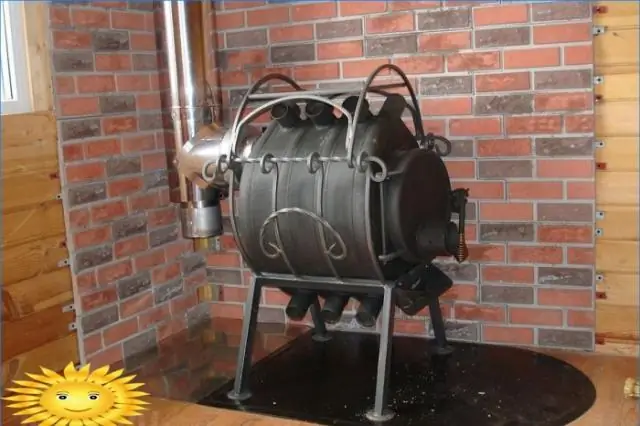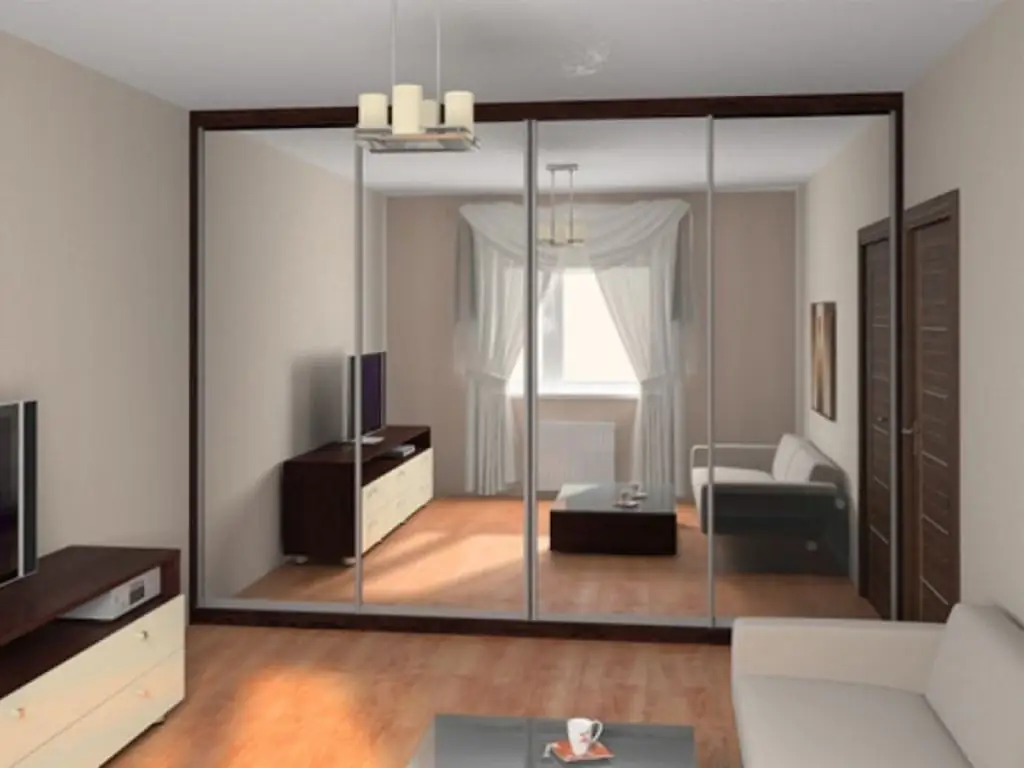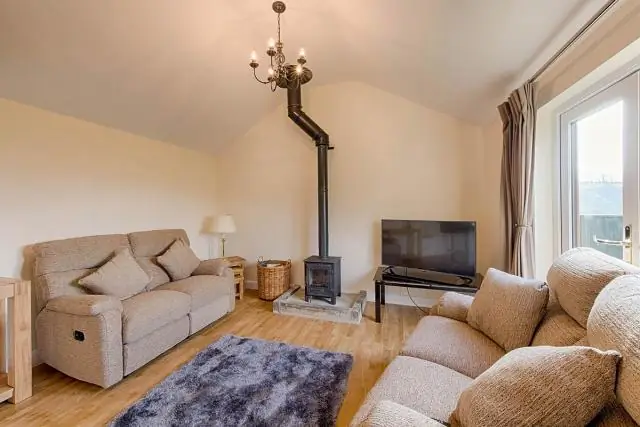
Table of contents:
- Fast and efficient heating of any room: do-it-yourself buleryan oven
- Advantages and disadvantages of a Canadian oven
- Varieties with photos and geography of using buleryan
- Design features and principle of operation
- Drawings and diagrams of buleryan for making with your own hands
- What you need to make a "Breneran" type convection oven
- Stove making instructions
- Improvement and modernization of the heater
- Correct operation and maintenance of the oven
- Author Bailey Albertson [email protected].
- Public 2024-01-17 22:26.
- Last modified 2025-06-01 07:32.
Fast and efficient heating of any room: do-it-yourself buleryan oven

The leadership in the manufacture of the "Buleryan" stove, or as it is also called, "Breneran", belongs to Canadian heating engineers, who were tasked with developing an effective small-sized structure for heating temporary housing for lumberjack brigades. The technical task was embodied in a solid fuel unit, vaguely reminiscent of a stove-stove familiar to everyone. Thanks to the improved combustion chamber and the use of forced convection, the specialists managed to increase the efficiency and reduce the time required to warm up the coldest room. Today, such solid fuel furnaces are mass-produced, and the model range of any manufacturer includes up to a dozen units that differ from each other both in power and design. Since prefabricated products often have a completely unaffordable price,we recommend making buleryan with your own hands.
Content
- 1 Advantages and disadvantages of the Canadian oven
- 2 Varieties with photos and geography of using buleryan
- 3 Design features and principle of operation
- 4 Drawings and diagrams of buleryan for making by hand
- 5 What you need to make a "Breneran" type convection oven
- 6 Instructions for making the stove
-
7 Improvement and modernization of the heater
- 7.1 Distribution of heat to the rooms of the house
- 7.2 Improving the appearance of the unit with brick or masonry
- 7.3 Alteration of a potbelly stove for liquid fuel
- 7.4 Installing the water circuit
-
8 Correct use and maintenance of the oven
8.1 Design and operating features of the heating system (video)
Advantages and disadvantages of a Canadian oven

As a matter of fact, being the same "stove-stove", Buleryan has a special charm and charm, doesn't it?
The specifics of using the Buleryan furnace initially presupposed compliance with several mandatory requirements, which subsequently made the unit known throughout the world. The design of the heater was supposed to provide:
- Mobility. Since the felling of trees involves constant movement through the forest, the stove for lumberjacks is constantly transported from one place to another, and from transport to the premises is carried by hand.
- Compactness. The unit must have a configuration and dimensions that make it possible to install the device in small temporary buildings.
- Safety. Since the operation of buleryan provides for the installation of a heater directly in the residential area, its design should exclude the possibility of carbon monoxide leakage. It was possible to make this possible due to the sealed working chamber and the decision in favor of a one-door scheme. It is also important that the configuration of the body prevents accidental contact with the hot metal of the furnace body.
- Performance. The use of forced convection makes it possible to warm up the room in record time. This condition is met thanks to a system of channels that accelerate air exchange.
-
The possibility of long-term work. The configuration of the working area and the design of the blower allows Buleryan to work for several hours from one load of fuel, and you can use wood, bark, chips, shavings, etc. as fuel.
It is not recommended to heat the stove with coal, since metal is not recommended because of the high combustion temperature of this fuel. housing overheats and deforms. As a result, the device geometry is curved, the furnace door does not close, cracks in the welded joints.
- Simplicity and reliability. When developing the design of the solid-fuel unit, the engineers took into account that it would be operated in places remote from civilization. For the manufacture or repair of a Canadian potbelly stove, no special equipment or expensive materials are required, and a little instruction is enough for a beginner to operate the furnace.
As you can see, the advantages of Buleryan were incorporated into the design at the design stage. Perhaps the developers did not even suspect that their brainchild would become so popular and would be used both in everyday life and in production. Of course, like any other design, this type of convection oven is not without some drawbacks. First of all, the unit achieves the declared performance only when using absolutely dry firewood. When the moisture content of the fuel is more than 10%, the released water vapor impedes the flow of air and reduces the intensity of combustion, which leads to a decrease in efficiency. In addition, like any potbelly stove, buleryan does not keep heat at all - it is enough for the fuel to burn out, as the temperature in the room begins to drop.

The model range of Buleryan type furnaces contains many types, differing in power and configuration
The disadvantages of the design include the fact that the operation of the furnace assumes a gas-generating mode of operation, in which the wood smolders more than it burns. This process is accompanied by increased smoke generation, which leads to the release of harmful substances and tar deposits in the smoke channel. Often, the outer part of the chimney and the surrounding areas of the roof are covered with an oily substance, which absolutely does not add to the attractiveness of the picture. It is also important that when installing the stove, additional requirements are put forward for thermal insulation and the height of the chimney, otherwise the efficiency of its operation will be reduced.
As you can see, the unit is not devoid of shortcomings, which both the developers themselves and the owners honestly point out. Nevertheless, the numerous advantages of Buleryan made this heater one of the most popular units on the market for compact solid fuel equipment.
Varieties with photos and geography of using buleryan
In order to understand the difference between Buleryan, Breneran, Buller, Butakov's stove and other types of convection ovens, let's take a closer look at all the nuances. First of all, we would like to note that Buleryan is a brand of the German company Bulerjan, which produces super-bourgeois. Often, furnaces of this type are called the shorter word buller. "Breneran" - the same units, but produced by domestic plants under license. The furnace developed in Russia by Professor Butakov is very similar in principle to the original design, but has some differences:
- convection heat exchangers recessed into the housing;
- cube shape instead of cylindrical;
- the use of an ash pan and grate;
- flat platform at the top of the body for warming food.
In fact, the use of a grate in a gas generating unit is unnecessary, since intensive firewood burning is expected only in the first minutes after ignition. In addition, its purpose is not clear, given that it is below the level of the blower. There are doubts about the effectiveness of the site for installing a pot or kettle. When entering the operating mode, the temperature of Buleryan rarely even reaches 75 ° C, so it will take a lot of time to warm up the food.

Butakov's stove is a modernized buleryan
Despite the fact that the heater was originally designed as a stove with an air heat exchanger, some craftsmen loop convection channels by connecting them to a water heating system. The resulting aquabuller, of course, has a right to exist, but the advisability of such a solution is questionable. Firstly, the heat capacity of air is 800 times less than that of water, therefore, a furnace designed for convection will operate with a reduced efficiency under conditions of liquid heat exchange. Secondly, even if Brahneran is taken as a long-burning unit, then this is also irrational, since there are more suitable specialized designs of solid fuel boilers using pyrolysis. Despite this, aquabullers have found their place in the line of units, which are modernized buleryan.

The water jacket turns the convection oven into a hot water boiler, which is called an aquabuller
Despite the fact that initially the heating stove was developed for domestic use, now Buleryan is widely used in all spheres of economic activity:
- for heating summer cottages and country houses, including wooden ones;
- in production workshops;
- for heating utility rooms;
- in garages and workshops;
- in baths and saunas;
- to maintain the required temperature in greenhouses;
- as heating units for country cafes and restaurants;
- for heating administrative buildings in rural areas, etc.
When installing buleryan, the power and dimensions of the heating unit must be taken into account, since it depends on whether the device can evenly heat the entire room. It is equally important to choose the right place for installing the Canadian stove, to equip the chimney in accordance with all the rules and ensure its regular maintenance.

Installation diagram of the convection unit
Design features and principle of operation
When developing the brandaran, Canadian experts used the long-known design of a long-burning convection boiler, called a hot-air furnace. Due to the increase in the furnace door, it became possible to load not only chopped logs, but also parts of rhizomes, as well as large blocks of wood. The new form of the ashtray - in the form of a pipe cut into the loading hatch - made it possible to abandon the two-door scheme. To adjust the amount of air required for fuel combustion, a throttle was installed inside the blower - a round rotary damper. The throttle control lever brought out to the outside allows, if necessary, to reduce or increase the air flow, thereby controlling the power of the buleryan.

Buleryan design
The furnace of the heating unit is a metal cylinder with tubular metal heat exchangers bent in the form of elbows cut in at both sides at equal intervals. Due to the fact that two-thirds of the diameter of the pipes are recessed into the body of the furnace and are in the combustion zone, the air receives up to 70% of the heat that is released when burning wood. The remaining kilocalories heat the body of the stove and are subsequently also spent on heating the room. Due to this distribution, the buleryan body usually heats up to only 60-65 ° С, while the air that comes out of the convection channels has a temperature of more than 100 ° С. It must be said that it is precisely the high heating rate that ensures the active suction of cold air masses in the lower part of the tubular heat exchangers and their ejection from the upper openings of the air heater.
The combustion chamber inside the device is divided into three chambers. In the lower part of the furnace, at a height of up to ¼ of the body diameter, a metal under or a removable grate is installed. You can do without these elements, but with them it will be easier to light the furnace and remove ash. Under the arch of the furnace, at the same distance from the body as under, a perforated metal sheet is welded in, which does not reach the loading hatch for a quarter of the buleryan's length. The upper chamber is intended for the afterburning of volatile compounds that are released during the operation of the unit in the gas generator mode.

Rapid air heating is provided by convection heat exchangers that make up the furnace frame
The combustion products are discharged through an opening located in the afterburner, from the rear wall of the unit. At the beginning of the smoke channel, a damper with a cut out 90-degree sector is mounted. In addition, there is a gap of at least 10-15% of the chimney diameter around the gate (a metal plate that regulates the chimney draft). This design makes it possible to set the correct draft and, at the same time, does not allow carbon monoxide to enter the room, even if the smoke channel is completely blocked during intense gas formation.

Increased requirements are imposed on the buller chimney
A horizontal section of the chimney departs from the outlet opening, designed to reduce the temperature of the combustion products, and then an elbow is installed, which directs the pipe vertically. Here, at the "real" units produced by Bulerjan, a device for pyrolysis combustion of gases, called an economizer, is installed. The chimney must be high enough to obtain high-quality draft and insulated so as not to allow the combustion products to cool down too much. If this requirement is not met, as well as when using fuels with a high moisture content, the temperature in the afterburner will be reduced, as a result of which the content of tar and other unsafe carbon compounds in the flue gases increases.
Drawings and diagrams of buleryan for making with your own hands
Despite the fact that manufacturers keep the exact parameters and drawings of the produced convection ovens a secret, it is not difficult to remove the dimensions from the finished product. Thanks to enthusiastic people, today we have almost a complete set of project documentation. I must say that in the manufacture of buleryan, it is important to observe the ratio of the sizes of all parts of the unit, therefore, for your conditions, you can adapt the drawings presented below as an example.
-

Buleryan's drawing - Buleryan door drawing
-

Buleryan's drawing - Buleryan's drawing
-

Buleryan's drawing - Buleryan's drawing
-

Buleryan's drawing - Buleryan's drawing
What you need to make a "Breneran" type convection oven
In order to get a truly reliable and durable heating unit, it is made of thick metal. The best material is considered to be heat-resistant boiler steel, which can be bought at specialized offices. Before starting work, prepare:
- steel sheet products with a thickness of at least 5 mm and a size of 1000x2000 mm;
- a sheet of heat-resistant steel 6 mm thick, 400 mm wide and 700 mm long;
- a small piece of steel sheet 3-4 mm thick for the manufacture of valves;
- steel pipe Ø110 mm - 4 meters;
- a round thick-walled pipe Ø57 mm or a profile metal pipe with a thickness of 4 mm and more and dimensions of at least 60x60 mm - more than 10 m;
- steel tube Ø15 mm - 40 cm;
- door rings cut off from Ø350 mm pipe;
- powerful hinges for fastening the loading hatch;
- handle with a locking mechanism for the door;
- pieces of steel bar Ø8 mm for the manufacture of levers for air and smoke dampers;
- asbestos cord.
Tools and fixtures that will be needed in the process of making a Canadian stove:
- powerful pipe bender;
- welding machine;
- angle grinder (grinder);
- cutting and cleaning discs;
- an electric drill and a set of drills for working on metal;
- a hammer;
- roulette.

Precise details can be obtained by cutting thick sheet metal with a gas torch
Stove making instructions
When starting to build a heating stove, it is better to do the work step by step. In this way, it will be possible to avoid mistakes and miscalculations that can entail the dismantling of welded parts and the need to redo ready-made assemblies. Our instructions are written in stages and take into account the experience of manufacturing the unit by more than one skilled worker, therefore, using the presented algorithm, you can do the work not only quickly, but also efficiently.
-
A pipe intended for the manufacture of convection heat exchangers is cut into identical pieces 120-140 cm long (at least eight pieces should be obtained), which are bent at an angle of 75-80 degrees using a pipe bending device. In this case, the radius of curvature should be 22-23 cm, and the discrepancy in the geometry of the parts should not exceed a few millimeters.

Pipe bender To obtain pipes with a given radius of curvature, you can use a manual hydraulic pipe bender
-
On the inner side of the two obtained blanks, slots are made, into which, at a slight angle to the heat exchangers, segments of 20-cm pipes Ø15 mm are installed so that at least 15 cm remains outside. After that, all the cracks are carefully welded. During installation, this pair of pipes is installed at the door, since they will provide air injection into the combustion zone.

Buleryan making Injection tube
-
The pipes are laid one on top of the other, alternately orienting them in opposite directions. To make the structure stable, slats are used, the thickness of which is equal to the diameter of the pipes.

Buleryan making Furnace skeleton assembly
In some cases, an assembly frame is mounted and each heat exchanger is welded. It is important that the protruding parts of the pipes are of the same length. The result should be a furnace skeleton, which consists of at least 4 heat exchangers installed on each side in a checkerboard pattern. In this case, the depth of the buleryan will be about 50 cm.

Buleryan making Installation using a support frame
-
The details of the furnace frame are welded together, after which the lower partition of the furnace is cut out of a steel sheet with a thickness of at least 5 mm. In order to reduce the time for fitting a metal part, a template is made from thick cardboard, after which its contours are transferred to rolled metal.

Buleryan making Curly blanks are best cut using a cardboard template
-
The partition is installed in place, after which the places of its abutment to the convection pipes are scalded with a continuous seam.

Buleryan making Installation of the lower partition
- The gaps between the heat exchangers are also covered with steel strips, each panel being pre-fitted using a separate template.
-
The joints of the furnace body with the pipes are welded with a continuous seam, after which the slag is removed and the quality of the welding is verified.

Buleryan making The furnace body is formed by metal strips installed between the heat exchangers.
- Two similar shaped elements are cut out of the steel sheet, which will form the front and back walls of the furnace. To avoid time-consuming adjustment, in the process of work they use the same method of obtaining the exact configuration of parts using cardboard templates.
- A Ø110 mm hole is cut out in the rear wall for installing the chimney, while in the front wall there is a Ø350 mm opening for arranging the loading door.
-
A T-shaped structure is made from two sections of 110-mm pipe, designed to remove combustion products and collect condensate. Its lower part is closed with a round steel flange, which is fixed with studs welded to the pipe with M8 thread. To remove condensate, a Ø15 mm threaded branch pipe is cut into the flange, on which a 1 / 2˝ ball valve is installed.

Buleryan making T-shaped flue pipe

Buleryan making Bottom flange with condensate drain valve
- A round valve with a diameter of 90-95 mm is made from a steel plate 4 mm thick, in which a rectangular sector is cut out. Bending a piece of Ø8 mm bar at an angle of 90 °, form a gate axis with a pivoting arm.
-
Using an electric drill with a Ø8.5 mm drill, set the rod in the center of the smoke channel, after which the damper itself is welded to it. After that, the T-shaped chimney unit is welded to the rear wall of the furnace.

Buleryan making The configuration of the smoke damper must ensure the removal of combustion products even in a closed state
-
A blower is made in a similar way. To do this, take a 100-mm piece of Ø60 mm pipe, into which a throttle is installed. Unlike a gate, the air damper must exactly match the internal dimension of the channel and close it without gaps. To fix the throttle in the desired position, it is equipped with a spring mechanism.

Buleryan making Gate and blower
-
A 40 mm wide ring cut from a 350 mm steel pipe is welded into the window of the front panel of the case.

Buleryan making Front wall with opening for fuel loading
-
A front door with a diameter of 370 mm is cut from sheet metal. In the lower third of the part, an opening is made into which the blower is welded.

Buleryan making Front door with blower
-
In order to ensure a tight fit of the door to the furnace window, a gas seal is installed on it. This unit is made from two steel strips 4 mm wide or pipe sections Ø350 mm, for which they are cut across. After that, a piece with a length of 50 mm is cut from the circumference of one part, and this segment is welded to the other. One of the rings should freely enter the loading opening, while the other should be installed on top of it with a small gap. The parts are welded to the door, ensuring the exact centering of all elements. After that, the gap between the rings is filled with an asbestos cord packing - it will serve as a sealing element of the structure.

Buleryan making Door design ensures tightness and prevents excessive heating
- To prevent the door from heating up during the operation of the furnace, a reflective sheet metal screen is mounted on it from the side of the firebox. In this case, it is important to provide an air gap of at least 3 mm and free access of air from the blower to the combustion zone.
-
Hinges and a locking mechanism are welded to the loading hatch. By the way, a tight clamping of the door can be achieved by installing an eccentric bolt, the device of which is illustrated below.

Buleryan making The design of the locking device with an eccentric mechanism will ensure good pressure of the door against the loading window
- The front wall of the buleryan is welded in the same way as the rear panel, after which the hatch and the bracket of the fixing device are mounted on it.
-
To supply additional air to the afterburning zone, the front wall of the furnace body is equipped with an injection device. The manufacture of this unit is not difficult, and its design can be seen in the lower photo.

Buleryan making Afterburner chamber injection device

Buleryan making The injection device of the afterburner is equipped with the simplest lock
-
Stand-legs are welded to the bottom of the stove in the front and rear of it, so that the distance from the edge of the heat exchangers to the floor is at least 200 mm.

Buleryan manufacturing Support legs can be bent on the same bender
-
Buleryan is connected to the chimney, after which the heating unit is fired up and tested.

Buleryan Collected buleryan at work
In work, it is important to observe accuracy and accuracy, so it is better to take several measurements each time, work slowly, clean welded seams and metal edges with a grinding wheel, etc. Do not forget about safety precautions. It is best to work outdoors or in a well-ventilated area, always wearing protective clothing, goggles, and gloves.
Improvement and modernization of the heater
The design of the Canadian stove is designed to heat one room, since walls and partitions create an obstacle for heated air flows. The aesthetic value of the interior suffers greatly from the installation of a metal unit in living quarters, and the need to throw firewood in the middle of the night so as not to freeze in the morning can hardly be called comfortable operation. Numerous owners of a heating stove are trying to solve these and other shortcomings of Buleryan. And, I must say, not without success.
Distribution of heat to the rooms of the house
In order to heat the whole house with Buleryan, and not one room, corrugated pipes are connected to the heat exchangers of the unit, which are led through the wall of the room, and the opening is ennobled with a decorative grill. Of course, the ideal option is the case when this type of heating is considered at the stage of building design. Then, in the walls of all rooms, special channels are provided for the supply of warm air. Nevertheless, even in a house built a long time ago, such a scheme can be realized if you install a heating stove in the basement, and run air ducts through the floor of each room on the floor. This fulfills the requirement for heat supply at the lower level and ensures the ease of maintenance of the unit.

Buleryan, equipped with air ducts, will heat every room in the house
Air heating of each room in the building will also require a slight improvement in the buller design. First of all, this concerns the air supply - the natural inflow will not be enough, therefore, collectors are mounted on the lower side of the unit on each row of heat exchangers, which will ensure the distribution of the air coming from the duct fans. The same collectors are installed at the outlet of each group of air ducts. They will mix air masses coming from sections of the unit with different temperatures. Insulated corrugated pipes are connected to the outlet collector, through which heat will spread to each room. Since the air temperature at the outlet of the heater reaches 120 ° C, when laying pipes through ceilings and partitions, the conditions provided for the installation of chimneys are observed.
Improving the appearance of the unit with brick or masonry
If you impose a brick on a Canadian unit, then you can simultaneously solve several problems:
- to increase the aesthetic value of the stove in the interior;
- ensure safety during operation of the unit;
- increase the heat capacity of the structure.
Buleryan, stylized as a fireplace or a Russian stove, looks especially advantageous, and if, in addition to this, the front door is equipped with tempered heat-resistant glass, then such a unit can create a unique atmosphere of comfort and home warmth, while also performing the main function of heating square meters.

The add-on, stylized as a Russian stove, turns the potbelly stove into an exclusive heating device

Buleryan completely hidden in masonry
If you decide to refine buleryan yourself with bricks, for example, for a bath room, then keep in mind that if the height of the loading hatch is less than 40 cm from the floor, it will be inconvenient to heat the stove, and in addition, the design of the structure will suffer. The masonry should be as close to the furnace body as possible, and the gaps between the brick and the furnace must be filled with brick strips, which are laid on the mortar. Remember - the masonry will act as a heat accumulator, therefore, how long the oven will be warm depends on its solidity. We remind you that during operation it is imperative to ensure that the inlet and outlet openings of the heat exchangers are outside the "fireplace", and construction debris does not enter the pipes. It is best to close the heat exchange channels with a rag for this time.
Alteration of a potbelly stove for liquid fuel
Despite the fact that the brehren was originally designed as a wood-burning stove, it can be converted to run on diesel fuel or on a cheaper fuel - used car oil. Of course, this heating method is not suitable for a living space, but for long-term heating of a garage or utility room it is quite.
To transfer Buleryan for working off, you will need:
- install a container for oil on a small elevation;
- extend the liquid fuel supply hose to the unit;
- cut a hole in the combustion door for the tube to which the fuel supply control valve is connected.

In order to remake buleryan for working on mining, it is enough to install a container for oil and a special burner
When using waste oil, it is important to ensure good traction and correct fuel flow. Sometimes, instead of a homemade dropper, a factory burner is installed on the hatch, specially designed for this type of fuel. Unlike a hand-made device, an industrial nozzle provides a more complete combustion of mining.
Installing the water circuit
As noted earlier, inquisitive minds have repeatedly altered the classic Buleryan for work in a liquid heating system. In the early stages, homemade products tried to loop all the heat exchangers into one loop. It turned out a coil, through which water circulated thanks to the use of a centrifugal pump. Later, a scheme was proposed, similar to the previously described design of the modernization of the unit for distributing the air flow throughout all rooms in the house. The upper and lower sections of the heat exchangers were welded into the cylindrical collectors, connecting the lower element to the return line, and the upper one to the supply pipeline. Thus, it became possible to install the unit not only in heating systems with forced supply of a coolant, but also when using natural fluid circulation. By the way, the lack of Buleryan,associated with the impossibility of working on high-temperature fuel such as coal, is eliminated by itself - due to the high heat capacity, water copes well with cooling the walls of the unit.

Buleryan with a continuous water jacket
As for the manufacture of buleryan "from scratch", they do it even easier. Instead of making a skeleton from heat exchanger tubes, the furnace body is completely made of sheet steel, obtaining a unit with a regular cylindrical shape. From above, the structure is dressed in another cylinder, which serves as a water jacket. Since the lower part of the potbelly stove heats up poorly, the stove must be shifted down relative to the casing. In order to use all the heat to the maximum, some craftsmen manage to draw a water circuit also to the exit of the smoke channel. The photographs show all the nuances of the described metamorphoses.

Displacement of the furnace body downward relative to the water jacket allows heating the water more efficiently
Correct operation and maintenance of the oven
For quick kindling of the furnace, finely chopped dry firewood is used, under which paper or cardboard is laid. After the wood is ignited, the main portion of the fuel is added to buleryan. I must say that thick logs up to 40 cm long are ideal for this unit - they will give off heat for several hours. You should not warm up the stove with a fully open damper for more than 20-30 minutes - the brehren is designed for smoldering fuel, so a large fire will simply carry away the lion's share of the heat energy into the chimney. In addition, a red-hot oven may warp or break one of the welds.
After the firewood is completely ignited, the stove is switched to gasification mode, for which the gate and choke are covered. The operation of the unit in the gas generator mode is evidenced by a small flame under the roof of the fuel chamber, accompanying the combustion of the evolved gases.
The efficiency of the unit depends on how dry the wood will be. Therefore, it is recommended to dry the fuel before filling. By the way, for this you can use the heat of the melted stove itself, if you put another heap of firewood on the heat exchange pipes.

Buller's versatility manifests itself even when drying wood
The smoke that fills the room when the potbelly stove is melted indicates one of the following errors:
- insufficient chimney height. Excellent traction characteristics will be provided by a pipe with a height of at least 5 m, while its upper cut must necessarily be located above the roof;
- the gate valve is closed;
- deposits of condensate and soot have narrowed the flue duct so that the normal removal of combustion products became impossible. They must be removed.
Furnace contamination during operation is manifested not only in the deterioration of traction. Deposits on the gate impede its normal closure, and a layer of soot on the inner surfaces of the heating unit significantly impairs heat transfer.
In order to clean buleryan, several methods are used, one of which involves burning out resins and soot. Experts do not recommend burning through the unit, since this is due to the heating of the furnace and chimney to too high a temperature. In addition, the process is often accompanied by uncontrolled ignition and the release of burning residues onto the roof.

Cleaning with soot burning is a big disaster
It is best to clean the buller and chimney with the old methods, using metal brushes and scrapers. Dirt and oily deposits are removed from the chimney by first removing the flange at its bottom. The inner surface of the combustion chamber can be brought into proper form with a small painting trowel or chisel.
The design and features of the operation of the heating system (video)
Difficulties in the manufacture of the Buleryan furnace may arise not due to the structural complexity of the unit, but due to the lack of necessary skills when working with welding and locksmith equipment. Nevertheless, do not despair prematurely - some of the work can be done independently, and the most difficult and crucial stages can be entrusted to professionals. Even in spite of the additional costs, the cost of a self-made heater can be reduced by two or more times compared to factory products.
Recommended:
How To Fold A Russian Stove With Your Own Hands: Device, Diagram, Step-by-step Instructions, Etc

The design of the Russian stove and the process of its construction with your own hands. Basic requirements for kiln work
How To Make A Bench With A Backrest With Your Own Hands - Step By Step Instructions For Making A Bench With Photos, Videos And Drawings

What benches are better to install in your personal plot. How to make a bench with a back with your own hands, what materials to use
How To Make A Long Burning Stove With Your Own Hands: Manufacturing Instructions With A Diagram And Drawings + Video

How to make a long burning stove with your own hands. Consumables, recommendations, diagrams, design features
How To Make A Wardrobe With Your Own Hands At Home: Step-by-step Instructions For Making, Installing Filling And Doors With Drawings And Dimensions

A detailed guide to making a wardrobe with your own hands. Design, marking, installation of internal filling, installation and adjustment of doors
Long-term Burning Stove (including Sawdust And Wood) With Your Own Hands: Diagram, Drawings, Etc. + Video

How does a long burning stove work. Production of a long-burning furnace from a gas cylinder and sheet metal. Features of operation and repair of furnaces
